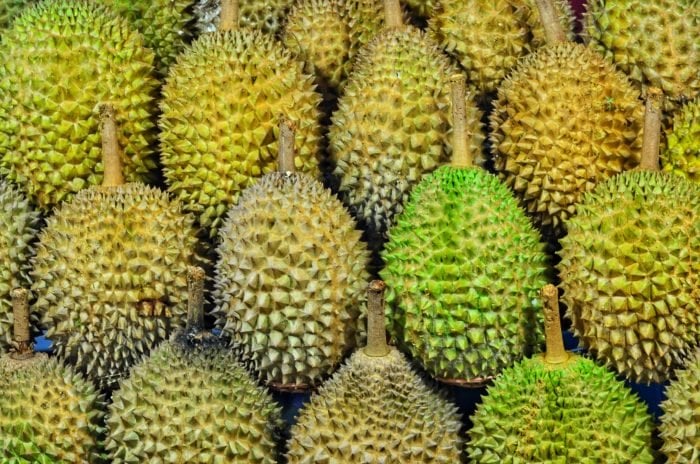13 Exotic Superfoods You NEED to Add To Your Diet

When was the last time you picked up a fruit you had never heard of before or at least tried? If you’re like most folks, you probably fill your grocery cart with the usual suspects—maybe some berries, apples, bananas, and citrus. And you rarely, if ever, veer off the familiar path. If so, it’s time to give exotic superfoods another look and start adding some lesser-known options into your cart.
Perhaps you’ve heard that increasing your food variety can lead to weight gain. This is definitely true if you’re in a buffet line or when your cart is loaded with a variety of sweets and processed foods. However, when greater varieties of fruits and vegetables and other healthy foods are consumed, research has found it protects against excess weight gain. 1
Eating a variety of healthy foods may even reduce the risk of early death. One study found that when women ate over 16 or 17 healthy foods, their risk of death decreased by 42% over women who consumed less than 9 of the healthy foods. 2 And folks who eat a more varied diet are up to 21% less likely to develop metabolic syndrome (that cluster of health issues that includes high blood pressure, high blood sugar, and increased body fat). 2
According to nutritionist Dr. Deanna Minich, eating a variety of colorful foods offers numerous benefits, 3,4 such as:
- Increased diversity and thus greater ecological stability, which means more dependable access to a wide range of vitamins and minerals
- A more varied, healthier gut microbiome
- Decreased risk of food allergies and intolerance
- Decreased inflammatory markers (e.g., C-reactive protein)
- Improved antioxidant effects
- Complementary actions of phytochemicals
13 Exotic Superfoods You Need to Be Eating More Often

1. Durian
Referred to as “king of fruits” in southeast Asia, durian is most well-known for its distinct scent, which can be strong or even unpleasant to some folks. It has a bristly outer coat and a soft, creamy inner flesh that’s high in vitamin C (80% of the Recommended Daily Intake or RDI), B vitamins, potassium, iron, as well as fiber (9.23 g per cup) and manganese, copper, folate, and magnesium. 5 It’s also very high in antioxidants, especially when ripe. A little goes a long way, however, as it’s also higher in calories than many other exotic superfoods with 357 per cup.

2. Pomegranate
Providing more than 100 phytochemicals, pomegranates provide numerous health benefits and have even been used in traditional medicine. While the skin is thick and not edible, once sliced into, you’ll find hundreds of juicy, sweet seeds called “arils” that can be eaten as is or juiced.
Pomegranates get their brilliant color from plant polyphenols and provide more antioxidants than most other fruits—and up to 3 times more than red wine or green tea. They’re also a great source of vitamin C, providing 300% of your daily requirements, as well as 36% of the RDI for vitamin K.
Pomegranates are a good source of folate and potassium and provide 7 grams of fiber with just 144 calories per cup. What they’re most well-known for is their rich supply of antioxidants like punicalagins and their potent ability to help the body fight off inflammation. 6 They’re delicious on their own and also so pretty on top of a salad or floating in some bubbly water.

3. Guava
Especially high in vitamin C (209% of the RDI in a single fruit or 4 times more than an oranges), guava is also high in vitamin A, folate, copper, potassium, manganese, and fiber—namely pectin, which supports healthy digestion. It’s also rich in antioxidants, including lycopene and other polyphenols, with a mere 38 calories each cup and boasting 3 grams of fiber. It can be eaten alone, with yogurt, or in a delicious smoothie and is purported to have numerous health benefits, such as improved immunity, digestion, and hormonal function.

4. Papaya
Another exotic superfood that’s loaded with nutrients, including vitamins A and C, potassium, and folate, and antioxidant carotenoids like lycopene. The body also absorbs the antioxidants found in papayas better than many other fruits and veggies. Papaya also provides papain, which is an enzyme that makes it easier to digest protein, especially meat. A small ripe papaya is sweet and provides just 59 calories and 3 grams of fiber. Keep refrigerated for a sweet, refreshing snack, or combine it with yogurt, chopped up into salsa, or added to a smoothie or salad.

5. Salak (aka snakefruit)
Nicknamed “snakefruit” because of its scaly outside, this southeast Asian fruit is described as sweeter than honey, incredibly juicy, with a citrus- or pineapple-like bite with an apple-like texture. It’s also high in vitamin C and beta-carotene (5 times more than found in mangos) along with fiber, iron, and protein. It’s revered for its positive effects on cognitive function and memory, partly due to its high potassium content. And, it’s low in calories, with just 82 in a 100-gram serving. The ripe fruit can be eaten alone or chopped up and added to a salad.

6. Sapodilla (aka sapota and chiku)
Don’t let the fleshy, brown, ugly exterior deter you. Once the ripe, soft fruit is sliced open, you’re rewarded with a very sweet, distinct, dense fruit that’s described as a mixture of plum and sticky pudding. Many enjoy the flavor alone as a dessert fruit or as part of a fruit salad. But because of its strong flavor, others prefer to mix it into a smoothie or even just into milk or yogurt or to naturally sweeten oatmeal.
Not surprisingly, it does contain more calories (and natural sugars) than many other fruits—in line with a banana with about 141 calories per fruit with 9 grams of fiber. So, it’s great for a quick boost of energy. It’s also a rich source of vitamins A and C, fiber, and of course, antioxidants. It’s high in tannins, which are polyphenols with numerous benefits. And sapodilla is a good source of calcium, phosphorus, iron, magnesium, potassium, zinc, copper, phosphorus, and selenium. 7

7. Dragon Fruit (aka pitaya, pitahaya, and strawberry pear)
With its bright red skin and green scales, the fruit is reminiscent of a dragon, thus the name. While it looks like an exotic superfood, the subtle flavor is more familiar—something like a cross between the more common pear and kiwifruit. With just 60 calories and 3 grams of fiber for a 3.5-oz serving, dragon fruit also provides magnesium, iron, and vitamin C along with several antioxidants, including betalains, hydroxycinnamates, and flavonoids. This highly versatile fruit is surprisingly easy to eat (despite its name and appearance) by just slicing it in half with a sharp knife and spooning out the flesh. It can also be chopped up and added to salads or on top of yogurt or oatmeal.

8. Rambutan
Another healthy exotic superfood native to southeast Asia, rambutan gets it name from the Malay word for hair as it looks a bit like a hairy red or green golf ball. It’s a rich source of vitamins, minerals, and plant phenols along with fiber. It’s a good source of vitamin C and copper and provides manganese, phosphorus, potassium, magnesium, iron, and zinc.
It has just 75 calories in a 3.5-oz serving. Plus, with both soluble and insoluble fiber, rambutan is well-known for helping promote healthy digestion and may also support weight loss.
If you’re unable to locate rambutan, other similar fruits include lychee and longan fruit.
To eat, remove the skin first, slicing in the middle of the fruit and then gently squeezing until the actual fruit pops out. Avoid the inedible seed in the middle by cutting it out or by spitting it out after eating the fruit. Rambutan can also be added to salads, curries, or desserts.

9. Jackfruit
You can’t tell by looking at it, but the giant jackfruit is in the same family as the humble fig. It has a unique flavor that’s often described as between a banana, an apple, and a pineapple. But what’s really unusual is its fibrous “meat-like” texture. In fact, it’s often used in vegan or vegetarian dishes to stand in for meat because the texture is similar to shredded meat.
A one-cup serving provides 155 calories with 3 grams of fiber and 3 grams of protein. It’s also a decent source of vitamin C, manganese, magnesium, copper, along with several types of antioxidants, such as carotenoids and flavonoids. Jackfruit also has a low glycemic index, due in large part to the fiber content, which can slow digestion and prevent blood sugar spikes.

10. Ugli (aka Jamaican tangelo)
A cross between a mandarin orange and a grapefruit, ugli has a sweet, citrusy flavor, and it’s particularly easy to peel. It’s generically called a tangelo, and Ugli is a brand name due to its rumpled, somewhat “ugly” peel. The insides, however, are similar to other citrus fruits, so once it’s peeled, you’ll be on familiar ground.
Low in calories (just 47 per half fruit) with 2 grams of fiber, ugli provides a whopping 90% of the RDI for vitamin C—a potent antioxidant and immune booster. It also provides phenols, folate, calcium, and potassium. This easy-to-eat, low-calorie snack can be eaten alone or added to any recipe that calls for citrus.

11. Persimmon
This exotic superfood hails from China where it is grown for its fruit and wood. With a pale orange color and a honey-like flavor, the ripe fruits can be eaten fresh, dried, or cooked. A single fruit supplies 118 calories and 6 grams of fiber. It’s also a healthy source of vitamins A and E and manganese and provides vitamins B6, E, and K and copper and potassium. Finally, persimmons have strong antioxidant qualities from flavonoids (e.g., quercetin and kaempferol) and tannins (e.g., tannic acid and gallic acid).
Because of their low calories and high fiber, they’re very weight-loss friendly. They can be enjoyed fresh or used in numerous recipes as they pair well with both savory and sweet foods. They can be added to a salad, yogurt, oatmeal, smoothies, and more.

12. Soursop
Soursop (aka graviola) is a green fruit with a prickly skin found in the tropical areas in the Americas. It’s got a strong flavor that’s been compared to pineapple and strawberry with a creamy texture. A 3.5-oz serving (soursops can be quite large and therefore may be best shared) provides just 66 calories, 3.3 grams of fiber, and 1 gram of protein. They’re also a good source of vitamin C, potassium, magnesium, and thiamine and, of course, antioxidants such as luteolin, quercetin, and tangeretin.
It is often eaten raw by cutting the fruit in half and scooping out the center. In South America, it’s also often found in juices, ice creams, and sorbets. It can be added to smoothies or used to sweeten baked goods. Look for a soft, ripe fruit, and avoid the seeds.

13. Custard apple (aka cherimoya)
Another exotic superfood that has a scaly skin is the custard apple, so called because of its sweet, creamy consistency that’s typically served chilled and eaten with a spoon (like custard). It can also be added to a fruit salad or mixed into a smoothie, yogurt, or oatmeal. Its flavor is described as a tropical fruit similar to a banana or pineapple.
A custard apple is packed with antioxidants, including kaurenoic acid, flavonoids, carotenoids (including lutein), and vitamin C and is an excellent source of vitamin B6 (over 30% of the RDI), potassium, and magnesium. You’ll also get a good, healthy serving of fiber (5 grams in one cup) to support digestion and gut health.
How to Add More Diversity to Your Diet
If you’ve never heard of many of these exotic superfoods, you may feel a bit overwhelmed with what to try first or how to add them to your existing meal plan. Have fun with increasing your diversity by: 4
- Challenging friends and family to see who can try the most unusual (at least unusual to them) fruits and vegetables in a month.
- Swap out some of your regular options with a similar but less familiar fruit. If you usually add a handful of berries to your morning protein shake, why not try papaya or sapadilla instead?
- Support your local farmers’ market or community supported agriculture (CSA) to try a variety of in-season produce.
- Take a cooking class to learn new ways to prepare healthy yet unfamiliar foods. For bonus points, take a class to learn how to cook your favorite ethnic dish.
- Invite friends and family over for a potluck dinner party and request that everyone choose an unusual ingredient for their dish
- It doesn’t matter what color your dish is, dress it up with lots of fun colors in the form of fruits and vegetables to get a variety of potentially synergistic antioxidants.
- Visit an ethnic market to discover foods from around the world you never even knew existed.
Enjoy going somewhere “exotic” in your own kitchen with any one of the exotic superfoods above, and have fun experimenting with new flavors and textures as you provide your body with loads of nutrients.








